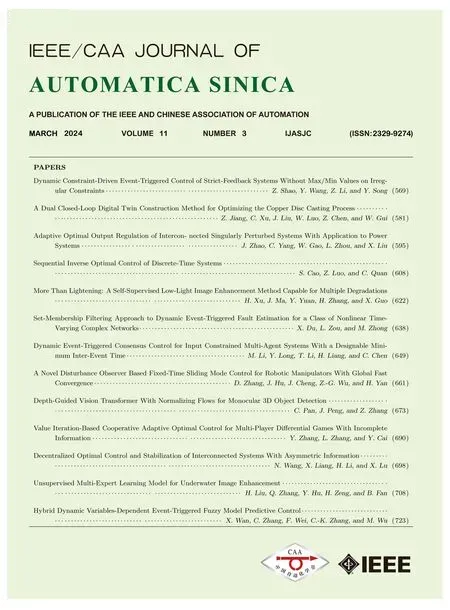Set Stabilization of Large-Scale Stochastic Boolean Networks: A Distributed Control Strategy
Lin Lin , Jinde Cao ,,, Jianquan Lu ,,, and Leszek Rutkowski , Life,
Dear Editor,
This letter deals with the set stabilization of stochastic Boolean control networks (SBCNs) by the pinning control strategy, which is to realize the full control for systems by imposing control inputs on a fraction of agents.The pinned agents are determined based on the information on the network structure, rather than the whole state transition, of an SBCN.Regarding each pinned agent, a mode-dependent pinning controller and a more economical mode-independent pinning controller are designed to stabilize SBCNs towards a given state set.Finally, a 90-nodal T-cell receptor signaling network is presented to illustrate the theoretical validity of the obtained results.
SBCN is a stochastic and controlled counterpart of Kauffman’s Boolean networks (BNs) [1] to model gene regulatory networks under uncertain gene interactions and therapeutic interventions.In the SBCN model, the expression of genes is quantified as states “1”(ON) and “0” (OFF), and the state update obeys logical functions,randomly selected from a candidate set at each time step.Beyond biological systems, the SBCN model has attracted considerable attention in potential games [2], multi-agent systems [3], networked knowledge [4], and smart home [5].Stabilization, as an essential issue in SBCNs, reveals the ability of systems to reach and stay at a desired attractor (fixed state or state set) [6]-[8].As discovered in the large granular lymphocyte [9], the full-zero steady state manifests programmed cell death, while some states indicate healthy and beneficial situations.
Recent efforts towards addressing SBCN-related problems are mainly based on the algebraic state space representation (ASSR)approach [10].The main idea of this approach is to convert the logical function into an algebraic form with a state transition matrix of exponential dimension.Although this approach facilitates the analysis and control of SBCNs, it encounters a high computational complexity, which restricts the application to small-scale networks.Lately, a remarkable framework is established in [11]-[13] to handle the (set) stabilization, controllability, and their minimal node control problems of large-scale BNs by integrating the information on the network structures.It not only mitigates the uncertainties in the nodal dynamics but also maintains the time complexity of designing pinning controllers for BNs at a relatively low level.However, these works focus on deterministic BNs, rather than a more general SBCN model.
Motivated by the above discussion, this letter aims to design a distributed pinning control scheme to stabilize SBCNs towards a given state set from the network-structural viewpoint.Key novelties of this scheme are three aspects: 1) The pinned agent is determined by finding the arcs from the non-functional agent set to the functional agent set, the minimum feedback arc set, and the agent with an undesired steady state.Compared with the pinned agent selection in [14] and[15],ourmethodonly uses the informationofthen-nodalnetwork structureinsteadofthe2n-nodalstatetransition, which extremely reduces the time complexity.2) Mode-dependent pinning controller to stabilize SBCNs is proven to exist.To reduce the control cost, a mode-independent pinning controller is further designed.3) A biological example is presented to reveal that this control design scheme is applicable to therapeutic interventions for large-scale T-cell receptor signaling networks.




Fig.1.Illustration of pinning controlled T-cell receptor signaling network.(a)Sub-digraph G; (b) Sub-digraph G Ωc.


Fig.2.Illustration of pinning controlled T-cell receptor signaling network.
Conclusion: This letter has investigated the problem of stabilizing SBCNs via a distributed pinning control strategy.The pinned agent set has been determined based on the network structure, and subsequently, mode-dependent and mode-independent pinning controllers have been constructed.A biological example indicates that stabilizing a 90-nodal T-cell receptor signaling network to S can only impose controllers on two agents.Besides, the maximum in-degree of allagentsbeing4 contributes to the timecomplexity ofcontroller design herebeingO(n2), which is muchless thanO(2n)in[14] and[15].
Acknowledgments: This work was supported by the National Key Research and Development Project of China (2020YFA0714301)and the National Natural Science Foundation of China (61833005).
 IEEE/CAA Journal of Automatica Sinica2024年3期
IEEE/CAA Journal of Automatica Sinica2024年3期
- IEEE/CAA Journal of Automatica Sinica的其它文章
- Dendritic Deep Learning for Medical Segmentation
- Achieving 500X Acceleration for Adversarial Robustness Verification of Tree-Based Smart Grid Dynamic Security Assessment
- Communication-Aware Mobile Relaying via an AUV for Minimal Wait Time: A Broad Learning-Based Solution
- Simulation Analysis of Deformation Control for Magnetic Soft Medical Robots
- Multi-Timescale Distributed Approach to Generalized-Nash-Equilibrium Seeking in Noncooperative Nonconvex Games
- Dynamic Vision Enabled Contactless Cross-Domain Machine Fault Diagnosis With Neuromorphic Computing
